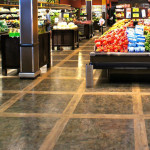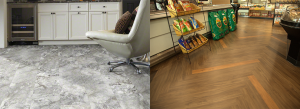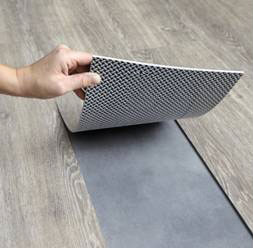Can You Recognize Luxury?

Luxury Vinyl Flooring can be found in many commercial environments, even high traffic locations such as supermarkets
With advancements in technology, many floor technicians have been thrown for a loop of late. Going into facilities now requires a floor tech to include investigator and detective into their job description. The flooring surface under their feet may not be the material that it initially appears to be. Wood grain does not mean you are standing on a wood floor. Do you see rich veining in what appears to be a stone floor in the room you are about to enter? It must be marble, right? Not so fast. Those floors which carry the aesthetic characteristics as hard wood or marble may very well be vinyl. Luxury Vinyl Tile (LVT) to be exact.
Advancements in technology and pressure to reduce maintenance costs have spurred the growth of LVT in recent years. The combination of new, cutting edge technology, economic value, and impressive initial visual appearance ensure that this type of flooring is more than a passing fad. LVT is here to stay and is likely to grow in popularity. As a floor technician you must be able to recognize this type of surface, either by asking the appropriate questions to facility personnel or by taking the time to visually and physically inspect the floors before beginning your maintenance procedures. If you go into the job thinking you will care for this type of surface as you have with the more traditional Vinyl Composite Tile (VCT) floors, you will likely do more harm than good and will likely inflict permanent damage on the LVT surface.
The popularity of LVT is mostly due to its ability to duplicate the look of solid hardwood or rich stone surfaces for a more economical price in both material and installation. Detailed, three dimensional printed images of various stone or hard woods are adhered as a layer on the vinyl and then protected with a top, polyurethane layer to ensure the floor continuously looks like authentic wood or stone and not a cheap contact paper or wallpaper-like flooring. LVT that is made to look like various stone surfaces is available typically in 12” x 24” or 18” x 18” tiles, which can be laid out adjacent to each other or separated to allow for a visible grout line to further authenticate the stone like appearance. LVT made to duplicate the look of wood is typically produced in 6” x 48” planks.
As a floor care professional, you are well aware that wood floor care and stone floor care are two of the more intricate and demanding types of floor care. Seeing more businesses and homeowners turn to a vinyl alternative to true stone or real wood may seem like a ticket to an easier work week. However, before making plans to put your feet up and taking it easy, make sure you are aware that while both LVT and VCT are in the vinyl flooring category, there are stark differences in how you care for a LVT floor compared to how you care for a VCT floor. Treating a LVT surface with the same exact maintenance procedures used on VCT could result in a permanently damaged floor and extremely upset customers and/or job superiors.
Traditionally it has been common procedure for floor techs to strip a newly installed VCT floor, remove the factory coatings, and apply anywhere from one to six coatings of a finish sealer or just a finish. With LVT, that factory coating is a polyurethane layer that acts as a wear layer and an important element of protection over the imagery that gives the floor its desired appearance. As a result, many manufacturers recommend not using floor strippers or solvents on LVT surfaces. They recommend, after initial installation, proceeding with general routine maintenance. Remove dirt and soils with a broom, dust mop, vacuum, or damp mopping. When using a vacuum, only use vacuums without bristle beater bars. Damp mopping can only be done after at least five days have passed since installation. Most manufacturers endorse the use of automated equipment in routine cleaning, but not at speeds that exceed 175 RPM’s, and only with a red or blue pad or a soft bristle brush attachment. Black or brown pads, along with hard bristle brush attachments are widely advised against using on LVT.
Some LVT manufacturers suggest not adding finish on top of the polyurethane top layer. Others suggest that if you are going to apply a finish to LVT, go with the initial matte finish appearance. But if a high gloss is desired, that can be accomplished, but with specific procedures. According to the consensus of manufacturers, the LVT must be installed for nearly a week before one can start the process of producing a high gloss. Many manufacturers recommend restricting foot traffic for the first 12 to 24 hours following installation and furniture placement for 24 to 48 hours post-installation. Wet maintenance should be avoided for the first five days after installation. If finish is going to be applied to the LVT, and since the use of strippers and solvents is not recommended, the alternative to preparing a LVT floor for a coating of floor finish is to use NCL Qwik Scrub, Scrub and Recoat Cleaner. During the typical VCT floor care life cycle, the scrub and recoat step comes after buffing restoration and prior to stripping and recoating. Qwik Scrub will deeply clean and remove a top layer of floor finish coating, preparing it for finish application to the LVT floor without impacting the integrity of the polyurethane coating.
After cleaning with Qwik Scrub, apply two to three layers of your desired NCL floor finish. An acrylic polymer based finish presents the best chance for adhesion to an LVT surface. While most finishes will adhere, it is always recommended to apply a small amount of finish in an inconspicuous test area before proceeding throughout the rest of the room or facility. With maintenance options limited from what you may be used to with VCT, if a high gloss is desired, it is imperative that a floor finish is chosen that will produce an impressive and brilliant “off-the-mop” gloss. During the lifetime of the finish on LVT, you can buff it to bring the gloss to the level first achieved when finish was initially applied. However, according to most LVT manufacturer warranties, buffing should only be done at a slow speed, 175 RPM’s, and with a white pad. LVT floors are NEVER to be burnished. When the floor finish gloss cannot be restored by simple buffing, proceed to a scrub and recoat procedure, but always skip the stripping step.
The manufacturers who advise against the use of strippers or solvents on LVT floors do not make exceptions in the case of staining. While polyurethane is typically resistant to staining, should staining occur, still rely on neutral cleaners, dampened white cloths, and elbow grease to remove stains and adhesives from LVT. As with all other surfaces, the installation of walk-off matting at appropriate lengths and entrance/exit positions and being consistent with daily maintenance play a big role in the appearance and preservation of the LVT surface.
If taken care of properly, LVT can be a durable and impressive flooring material. Building service contractors, facility managers, and floor technicians are on the front lines to ensure that proper procedures are followed and the LVT floors continue to look as impressive down the road as they do after initial installation.

Advances in LVT flooring make it a viable option for those who want the look of stone or wood flooring with the maintenance of vinyl.
We here at NCL are available to help with any questions you may have concerning the care and maintenance of LVT, VCT, or any other flooring surface. We also are here to help with your Jan San questions off of the floor as well. Questions and comments are welcome at:
(800)-NAT-CHEM
(215) 922-1200
Or, tweet us a question to @nclonline
 English
English Español
Español

